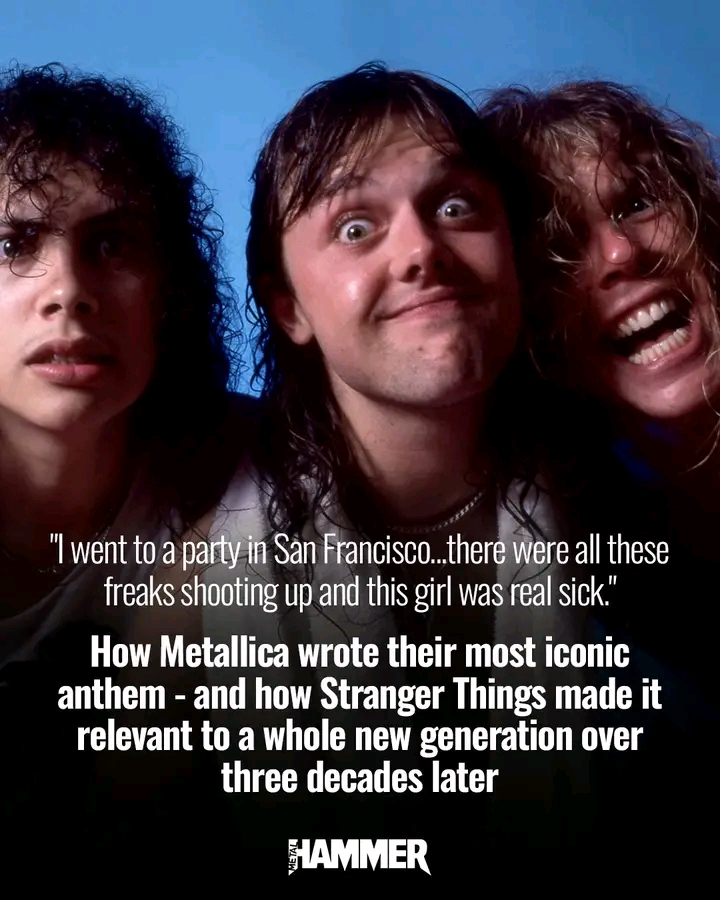
Metallica has always been one of those rare bands that transcend generations. Whether you first heard them blasting through a boombox in the late ’80s, discovered them through the “Black Album,” or stumbled upon them decades later through streaming playlists, there’s no denying that their sound has shaped the fabric of rock and metal culture. But every once in a while, something unexpected happens that sends a legendary song roaring back into the cultural spotlight and this time, the catalyst wasn’t a new tour, a remastered album, or even a Metallica announcement. It was a hit TV show that turned one of their most celebrated anthems into a symbol of emotional connection for an entirely new age of fans.
What happened next can only be described as a Metallica shockwave.
For decades, the song in question defined a generation of thrash-metal faithful those who felt the rawness, rage, power, and soul poured into every riff. It was the kind of track that didn’t just play in the background of life but shaped it. Fans grew up with it. Bands were formed because of it. Musical styles were influenced by it. And countless young rock fans picked up their first guitar after hearing that iconic opening.
But fast forward to today, and the anthem has taken on a completely new identity one that nobody, not even longtime fans, saw coming.
The revival began when the song was featured in a pivotal moment of a hit streaming series one of those emotional, high-stakes scenes where music isn’t just background but storytelling fuel. Suddenly, Metallica’s classic thunder wasn’t just driving mosh pits or blasting through arena speakers. It was carrying an entire generation of young viewers through heartbreak, survival, connection, and catharsis.
And just like that, the world erupted.
Millions of viewers rushed to find the track. Streaming numbers skyrocketed overnight. YouTube comments exploded with fans saying things like: “I’m here because of the show, but this song speaks to my soul,” and “How did nobody tell me Metallica was THIS good?” Meanwhile, longtime fans smiled knowingly because they had been saying that for decades.
But this wasn’t just a spike in streams or a brief nostalgia wave. Something deeper was happening.
For older fans, the song already carried its own meaning marking everything from teenage rebellion to the first time they heard a guitar riff that felt like electricity. But for new listeners, the emotional context created by the series breathed fresh life into every verse, every riff, and every pounding drum hit. The song wasn’t just being rediscovered; it was being reinterpreted.
Suddenly, the anthem wasn’t merely a thrash-metal landmark. It became a cinematic symbol of resilience, connection, and emotional release. It represented characters fighting for their lives, loved ones being pulled apart and reunited, and entire worlds shifting under the weight of crisis. The show didn’t change Metallica’s song but it revealed layers that even longtime fans hadn’t fully considered.
And Metallica themselves noticed.
Members of the band have always embraced new generations discovering their music, but sources close to the group say the band was genuinely moved by how deeply fans connected with the song’s new meaning. It reminded them of why they wrote it in the first place, and why their music continues to resonate so powerfully even decades later.
This revival has also sparked conversations in rock communities about the lasting power of music. How can a song written in one era suddenly feel brand new in another? How can a thrash-metal track from the ’80s or ’90s suddenly reduce millions of viewers to emotional wrecks because of a single onscreen moment? And how is it that a younger generation, raised in a completely different musical landscape, can relate so intensely to lyrics and sounds created long before they were born?
The answer is simple: authenticity lasts.
Metallica didn’t write music to chase trends. They wrote music to express something raw and real something that outlives the decade it was created in. So when a modern show features that kind of song, the emotional impact hits twice as hard: viewers experience the story, but they also feel the history.
And this is exactly why Metallica has remained not just relevant, but powerful.
As the song continues to climb the charts again yes, decades later it’s clear that the shockwave is far from over. Record stores are reporting increased vinyl sales. Guitar tutorials for the song are trending. Old fans are reconnecting. New fans are forming emotional attachments as strong as those who first heard it in the ’80s and ’90s.
What makes this moment so magical is how it bridges eras. It’s not just older fans being validated or younger fans discovering “real music.” It’s something deeper: proof that great art never dies it just waits for the right moment to rise again.
And this particular moment happened to come from a TV show that nobody expected to ignite such a musical resurgence.
Metallica’s celebrated anthem once a symbol of aggressive rebellion is now a cultural connector. A multi-generational force. A rediscovered masterpiece shaped by both nostalgia and emotional storytelling. And in a time when the world feels divided in countless ways, it’s rare and refreshing to see people of all ages unite over a song that has already lived so many lives.
This is more than a revival.
This is a Metallica shockwave, and it’s shaking the world all over again

Leave a Reply